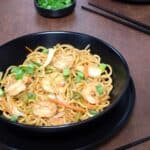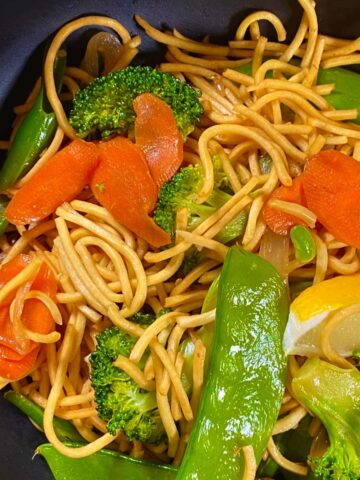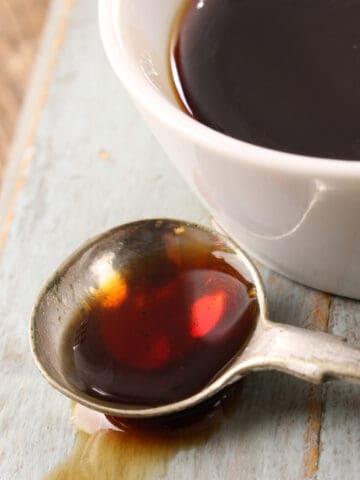Ponzu and Soy Sauce have been staples in Asian cooking. In this blog, we'll explore these sauces in-depth, learn the differences between the two, understand their unique characteristics, and how they enhance various dishes.
Jump to:
- What is Ponzu Sauce?
- How is Ponzu Sauce Made?
- Ponzu Sauce Varieties
- What is Soy Sauce?
- How is Soy Sauce Made?
- Soy Sauce Varieties
- Differences Between Ponzu and Soy Sauce
- Similarities Between Ponzu and Soy Sauce
- Choosing the Best Sauce
- Proper Storage
- FAQ
- Conclusion
- Recipes with Soy Sauce
- Philippine Cuisine
- 💬 Reviews
What is Ponzu Sauce?
Ponzu, widely used in Japanese cuisine, is a citrus-based sauce. It is a blend of tangy, fruity notes with umami undertones.
Its history links back to the 17th century, with a nod to Dutch influences. The name 'ponzu' itself is a testament to its origins, combining "pons" (Dutch for punch) and "zu" (Japanese for vinegary).
Its base is citrus juice, often yuzu, lemon, or lime, which imparts a dominant tangy flavor. This is balanced with ingredients like mirin, rice vinegar, soy sauce, bonito flakes (shredded tuna), and kombu seaweed, creating a symphony of flavors – tangy yet subtly salty and unmistakably umami.

How is Ponzu Sauce Made?
Ponzu's creation is an art. The process involves blending citrus juices with mirin or sake and rice wine vinegar. This mixture is then infused with flavors from bonito flakes and kombu. The result is a light, tart sauce, embodying both fruity and umami essence.
Ponzu Sauce Varieties
- Citrus Type: The choice of citrus (like yuzu, lemon, lime, or orange juice) alters the tartness and acidity. Yuzu ponzu, for instance, offers a unique, aromatic tartness distinct from the more common lemon or lime ponzu.
- Additional Ingredients: Different combinations of mirin, rice vinegar, bonito flakes, and kombu seaweed can affect the sweetness, umami level, and overall flavor complexity.
What is Soy Sauce?
Soy sauce, originating from China, stands as one of the most popular condiments in Asian cooking.
It's a fermented sauce made primarily from soybeans and wheat, with a strong salty flavor and a subtly sweet, umami undertone.
Japanese sauce, known as shoyu, incorporates a specific fungus in its fermentation process, enhancing its umami profile while introducing a unique sweetness.

How is Soy Sauce Made?
The journey of making soy sauce begins with soaking and fermenting soybeans and wheat with a yeast culture. This long fermentation period, sometimes extending up to two years, cultivates its deep, rich flavor and color.
Soy Sauce Varieties
- Light vs Dark Soy Sauce: Light soy sauce (usukuchi shoyu) has a saltier, less intense flavor suitable for delicate dishes, while dark soy sauce (koikuchi shoyu) is richer, slightly sweeter, and used for color in dishes.
- Regional Variations: Chinese soy sauce tends to be saltier and more robust than Japanese soy sauce (shoyu), which has a more balanced, slightly sweet flavor due to the inclusion of wheat in its fermentation process.
Differences Between Ponzu and Soy Sauce
Ponzu and soy sauce, integral to Asian cuisine, differ notably in their composition, flavor, and culinary applications.
Composition
- Ponzu: A Japanese citrus-based sauce, ponzu includes a mix of citrus juice (like yuzu, lemon, and lime), rice vinegar, mirin, soy sauce, bonito flakes, and kombu seaweed. It's a citrusy tart sauce with a hint of umami flavor.
- Soy Sauce: Made primarily from fermented soybeans and wheat, soy sauce (or shoyu in Japanese) offers a strong umami and salty taste. Some varieties, like koikuchi shoyu, might have a slightly sweeter note due to added ingredients.
Flavor Profile
- Ponzu: Known for its tangy, citrusy tartness balanced with a subtle umami undertone. It's a flavorful condiment, adding a flavor without overwhelming the taste buds.
- Soy Sauce: Predominantly salty with a deep umami flavor. Dark soy sauces can be sweeter, while light soy sauce offers a more balanced saltiness. Shoyu, a Japanese soy sauce, is known for its savory-sweet balance.
Culinary Uses
- Ponzu is versatile and ideal for marinades, dipping sauces, and salad dressings. It's not suited for high temperatures, so it's often added towards the end of cooking to maintain its citrusy tartness.
- Soy Sauce is a staple in Asian cooking, used in various dishes from stir-fries to soups. It's heat tolerant and can be added at any cooking stage. It's a popular condiment for adding salty and umami flavors without the citrusy tartness of ponzu.
While you can substitute ponzu for light soy sauce in some cases, their distinct flavors mean they are not always interchangeable. Ponzu adds a citrusy tartness and sweetness, which soy sauce lacks. Conversely, using soy sauce instead of ponzu would require additional ingredients like citrus juice to replicate ponzu's unique flavor.
In essence, while ponzu and soy sauce enhance Asian dishes, their distinct flavor profiles and uses cater to different culinary needs, enriching the diverse palette of Asian cuisine.
Similarities Between Ponzu and Soy Sauce
Despite their differences, ponzu and soy sauce share some key similarities, particularly in their roles in Asian cuisine:
- Japanese Origins: Both sauces are staples in Japanese cooking, often used in traditional dishes like sushi, sashimi, and various noodles.
- Versatility: Each sauce is incredibly versatile, suitable for use as marinades, dipping sauces, and to enhance the flavor profile of various dishes.
- Umami Flavor: Both ponzu and soy sauce contribute an umami flavor to dishes, although the level and complexity of this flavor differ between the two.
- Sweetness Balance: There's an element of sweetness in both sauces, which helps balance their stronger flavors - the tartness in ponzu and the saltiness in soy sauce.
- Popularity in Western Countries: Both have grown popular in the West as Japanese and Asian cuisines have become more mainstream, finding their way into numerous fusion and experimental dishes.
Choosing the Best Sauce
Choosing the best Ponzu and Soy Sauce involves considering a few key factors:
Ponzu Sauce
- Citrus Quality: Look for ponzu made with high-quality citrus like yuzu or sudachi for a superior tart flavor.
- No Artificial Additives: Opt for ponzu without artificial preservatives or flavorings to enjoy the authentic flavor.
- Ingredient Balance: A good ponzu should have a perfect balance between its citrusy tartness, slight sweetness, and umami from ingredients like bonito flakes and kombu seaweed.
Soy Sauce
- Fermentation Process: Traditional, naturally fermented soy sauces (like koikuchi shoyu) usually offer a richer flavor than chemically produced ones.
- Regional Varieties: Choose based on your taste preference: Japanese soy sauces (shoyu) tend to be milder and slightly sweet, while Chinese soy sauces are often stronger and saltier.
- Specific Use: Consider the dish you're preparing – light soy sauce for subtler flavors or dark soy sauce for richer, more intense dishes.
Both sauces come in various brands and qualities, so tasting different types can help you find your preferred flavor profile for your culinary creations.
Proper Storage
Ponzu Sauce Storage: Given its citrus base and ingredients like rice vinegar and citrus juice, ponzu sauce should ideally be stored in a cool, dark place, preferably in the refrigerator once opened. This helps preserve its citrusy tartness and prevents the degradation of flavors that can occur at higher temperatures.
Soy Sauce Storage: Soy sauce, whether a light soy sauce, dark soy sauce, or Japanese shoyu, is generally more stable due to its fermentation process. However, to maintain its authentic flavor and prevent oxidation, it's recommended to store soy sauce in a cool, dark place, away from direct sunlight. Refrigeration after opening can extend its shelf life and preserve its umami flavor and aroma.
FAQ
Traditional ponzu may contain soy sauce, which includes wheat. However, gluten-free versions can be made using tamari (a wheat-free soy sauce alternative) or by ensuring the soy sauce used is labeled gluten-free.
Ponzu and soy sauce are typically vegan, as they do not contain animal products. However, some ponzu varieties include bonito flakes (fish flakes), so it's important to check the label or make a homemade version without animal-derived ingredients.
For those allergic to soy, alternatives like coconut aminos can be used. This soy-free condiment mimics the salty, umami flavor of soy sauce without containing soybeans.
For individuals with citrus allergies, traditional ponzu, which contains citrus juice like yuzu, lemon, or lime, should be avoided. Alternatives without citrus ingredients or homemade recipes can be used to replicate ponzu's flavor profile without using citrus.
Standard soy sauce is safe for those with seafood allergies. However, ponzu often contains bonito flakes, which are made from fish. Those with seafood allergies should seek ponzu varieties without bonito flakes or make their own seafood-free version.
Conclusion
Ponzu and soy sauce, each with their distinct flavors and culinary applications, are indispensable in Asian cuisine. Whether it's adding a citrusy tartness with ponzu to a Stir Fry Beef with Sriracha Sauce or intensifying the umami in a Filipino Beef Steak Recipe with Onions (Bistek) using soy sauce, these condiments offer endless possibilities to elevate your cooking. Explore, experiment, and enjoy the diverse world of flavors they bring to your culinary creations!
Recipes with Soy Sauce
Looking for recipes using soy sauce? Try these:
Philippine Cuisine
These are some of my favorite Filipino dishes:
What's The Difference Between Ponzu vs Soy Sauce
Instructions
Composition:
- Ponzu: A Japanese citrus-based sauce, ponzu includes a mix of citrus juice (like yuzu, lemon, and lime), rice vinegar, mirin, soy sauce, bonito flakes, and kombu seaweed.
- Soy Sauce: Made primarily from fermented soybeans and wheat, soy sauce (or shoyu in Japanese) offers a strong umami and salty taste.
Flavor Profile:
- Ponzu: Known for its tangy, citrusy tartness balanced with a subtle umami undertone.
- Soy Sauce: Predominantly salty with a deep umami flavor.
Culinary Uses:
- Ponzu is versatile and ideal for marinades, dipping sauces, and salad dressings.
- Soy Sauce is a staple in Asian cooking, used in various dishes from stir-fries to soups.




























Comments
No Comments